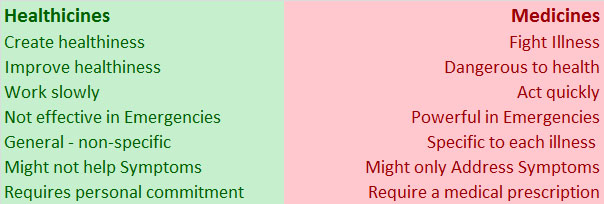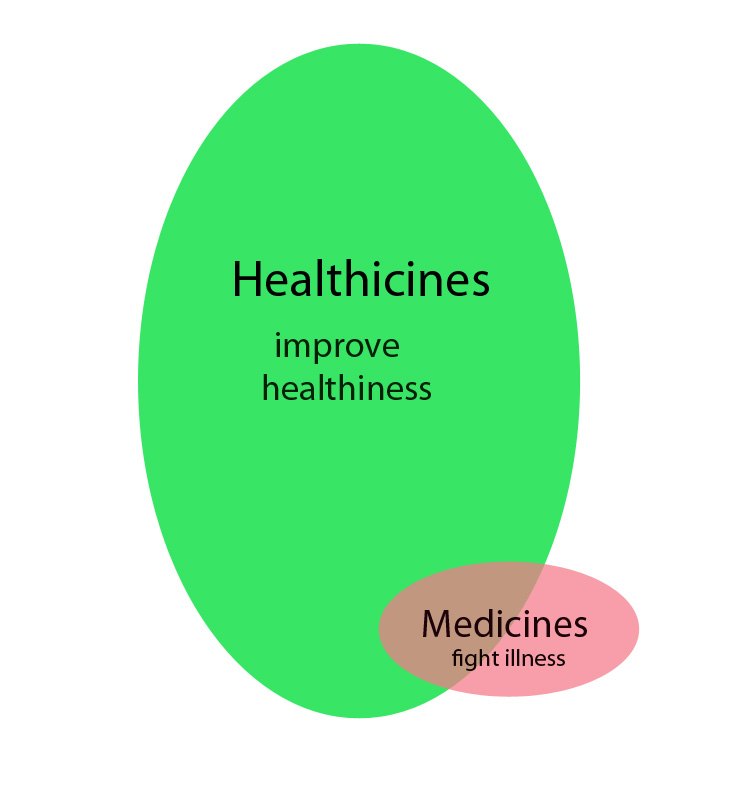Healthicines improve your healthiness. Medicines attack your illness. This is an important distinction that is not currently recognized by our medical systems. Healthicines can make you healthier when you are well, and they can make you healthier when you are sick. Of course too much of a good thing can also be unhealthy.
An apple a day keeps the doctor away. An apple is a healthicine, not a medicine. You can eat as many as you want. Your children can eat them. Apples don’t make you healthy ‘quickly’, health is created slowly, “an apple a day“. Apples don’t fight specific illnesses, they improve general healthiness. If you are sick, an apple won’t make you well and if you eat too many, you will get diarrhea. But if you are sick, an apple a day will still help you be healthy. You don’t need a prescription to buy an apple.
Medicines attack your symptoms, or your illness. Most medicines are toxic to your health, as well as your illness, but their power strikes the illness stronger – and your health can recover slowly. We might classify some medicines as healthicines, in specific situations. However, medicines taken at the wrong time – can only decrease healthiness. They are, in effect ‘medicines first, healthicines as a ‘side effect’.Wrong medicines are clearly not healthicines. A wrong medicine is toxic. As a result, many medicines are only healthicines some of the time.
A Vitamin is a healthicine. It is not a medicine, it is an essential nutrient. If you are deficient in a Vitamin, then consuming the vitamin will increase your healthiness. There is no medicine that will cure if you are sick from a Vitamin deficiency. We don’t study healthicines from a ‘health perspective’. There are lots of illness studies of Vitamins and well defined deficiency levels and upper limits for Vitamin consumption – but there are no recommendations for optimal healthiness.
An antibiotic is a medicine. If you have an infection, the right antibiotic will kill the bacteria (and possibly also some healthy cells and bacteria), giving your body time to recover. The wrong medicine, or a medicine taken when you are not sick – does not increase your healthiness. Medicines can only improve healthiness when the diagnosis, and the prescription is correct.
This distinction between healthicines and medicines applies to all health actions and medical treatments. If you break your leg, the cast or splint is a medicine, that reduces your healthiness to give your body time to heal. Getting some sunshine is a healthicine, that increases your Vitamin D, and your attitude – but like all healthicines, can be dangerous in excess. Singing and dancing is a healthicine, increasing the healthiness of your body, your mind, your spirit, and your community.
Some medicines are simply not healthicines. An extreme example is amputation. If you have gangrene in your leg, and the only option is amputation – the medical treatment does not make you ‘healthier’. It only fights the illness.
Many medicines only treat symptoms, without addressing health, and can actually make you less healthy. These are clearly not healthicines.
This table summarizes key differences between a healthicine and a medicine.
A medicine is of little use when you are not sick. A healthicine, on the other hand, can improve your healthiness whether you are sick, or healthy. Remember that healthiness is independent of illness. If you are very healthy, and you get a cold, you will recover from the cold faster. If someone who is unhealthy gets a cold – it will last longer. There are no recognized medicines to cure a cold, but when you have a cold, you can work to improve your healthiness. But remember that changes to health take place slowly.
Medicines are dangerous, they act quickly and can be toxic. As a result they typically require a medical diagnosis and prescription. Healthicines are slow acting, generally non-toxic or much less toxic.
Many medicines are simply healthicines. They make you healthier – but we don’t consume them as part of our general diet. The distinction between a healthicine and a medicine is sometimes just ‘intent’. If we intend to do something to improve our healthiness – it’s a healthicine. If we intend for our actions to fight our illness, it’s a medicine.
The line gets fuzzier when our intent is prevention. Improving our healthiness prevents illness. But sometimes, medicating also prevents illness. Healthicines prevent illness by improving our health. Medicines prevent illness by fighting illness or causes of illness. Eating a healthy diet promotes healthy teeth and gums. Brushing our teeth with toxic materials fights dangerous bacteria in the mouth. The healthy diet is a healthicine, brushing with toxins is a medicine. Both are done to prevent illness.
We can take many actions to improve our healthiness. We might eat healthy foods and participate in healthy activities. Sometimes, you might take actions that decrease your healthiness, intentionally or not. Many actions are taken with the intention of improving one aspect of healthiness – trading it for another aspect of healthiness.
This diagram shows the relationship between healthicines and medicines. Some medicines are healthicines, but not all.
When medicines work, they are healthicines. When they don’t work, they are simply toxins.
From a healthicine perspective, there is little difference between alternative medicines and patent medicines.
But in truth, a higher percentage of alternative medicines are healthicines. Many alternative medicines are in the area between healthicines and medicines – or we simply don’t know. No-one attempts to classify medicines into healthicines, or to identify the healthicine aspects of natural medicines. Patent medicines are unnatural, and therefore less likely to be healthicines. Natural medicines tend to be less toxic than patent medicines, but might act through toxicity, or through healthing. Because natural medicines are from nature, they are more complex than patent However, our medical establishments do not distinguish between healthicines and medicines. There is little study in this area.




